Artichokes, with their unique appearance and delightful flavor, are a fantastic addition to any garden. These perennial plants not only offer a delicious harvest but also boast ornamental value.
In this guide, we’ll explore the ins and outs of growing and caring for artichokes, so you can enjoy the taste of this delectable vegetable straight from your garden.
Benefits of Growing Artichokes
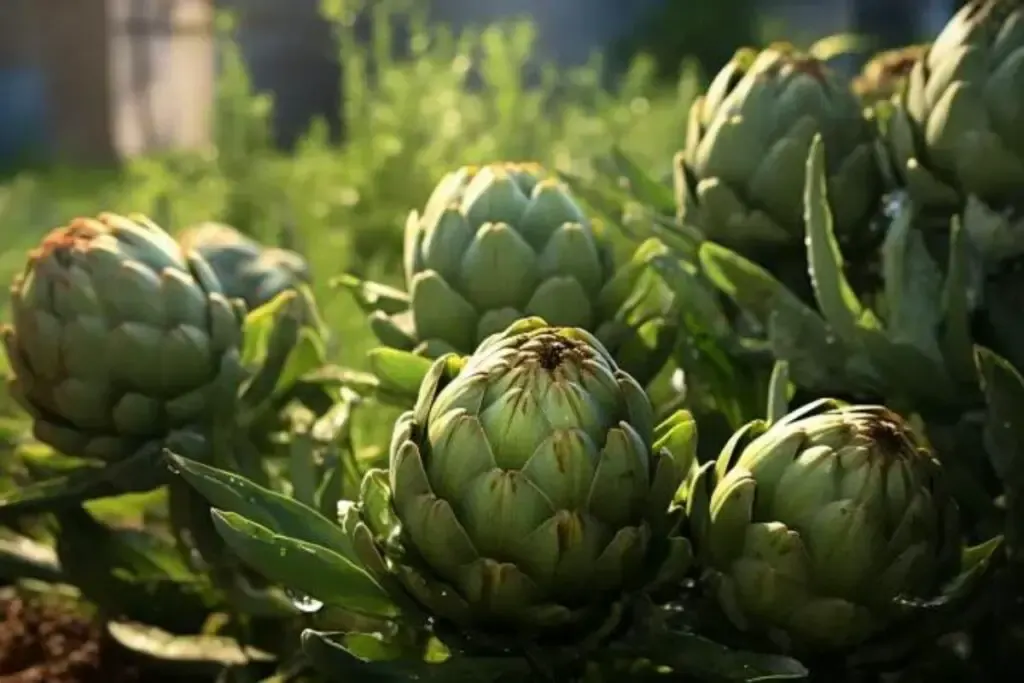
1. Nutrient-Rich Harvest
Artichokes are packed with essential nutrients like fiber, vitamins, and antioxidants. Adding them to your diet can promote better health and well-being.
2. Ornamental Appeal
Artichoke plants feature striking, silvery-green foliage that adds an attractive and unique touch to your garden landscape. They’re not just a culinary delight but also an aesthetic one.
3. Perennial Bounty
Artichoke plants are perennial, meaning they return year after year with minimal effort. Once established, they can provide you with a steady supply of delicious artichokes.
My Favorite Artichoke Varieties
When it comes to artichoke varieties, there are several to choose from, each with its unique qualities.
Here are a few of my favorites:
1. Green Globe Artichoke
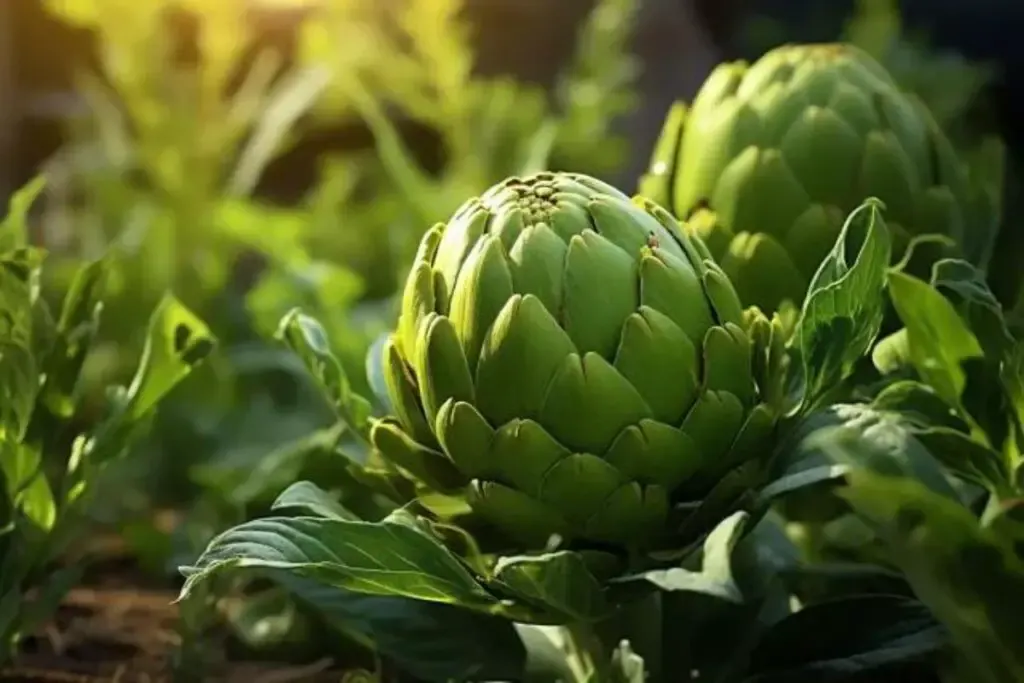
This classic variety is known for its large, globe-shaped heads and tender, flavorful hearts. It’s the go-to choice for many gardeners and a great option for beginners due to its reliability.
2. Purple of Romagna Artichoke
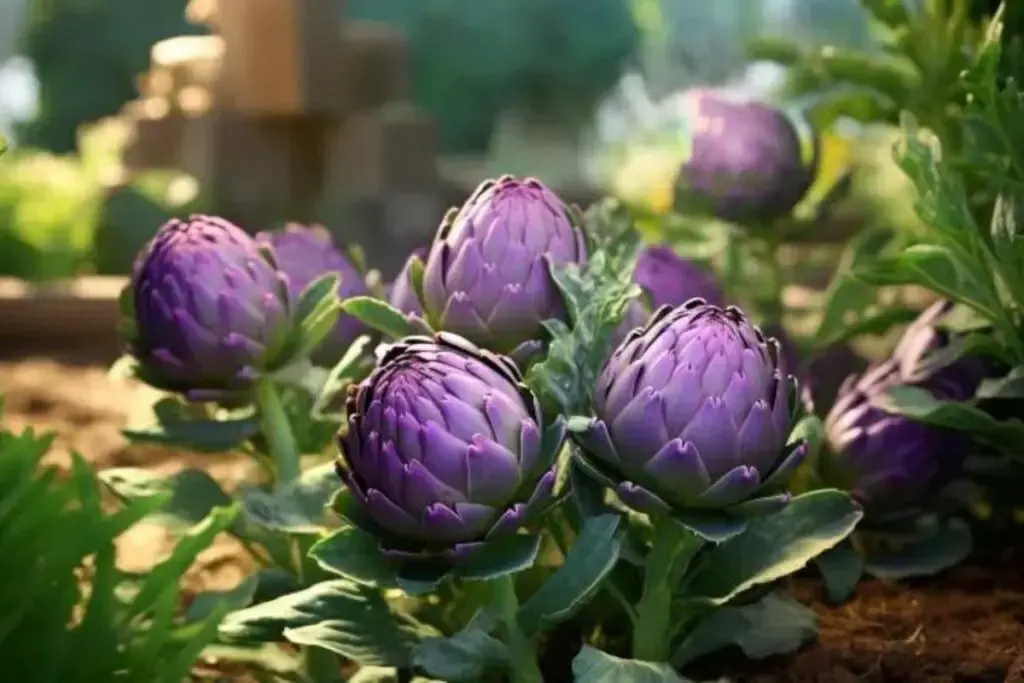
If you’re looking to add a touch of color to your garden, consider this variety. The Purple of Romagna artichoke features vibrant purple-tinged leaves and produces tender, nutty-flavored artichokes.
3. Imperial Star Artichoke
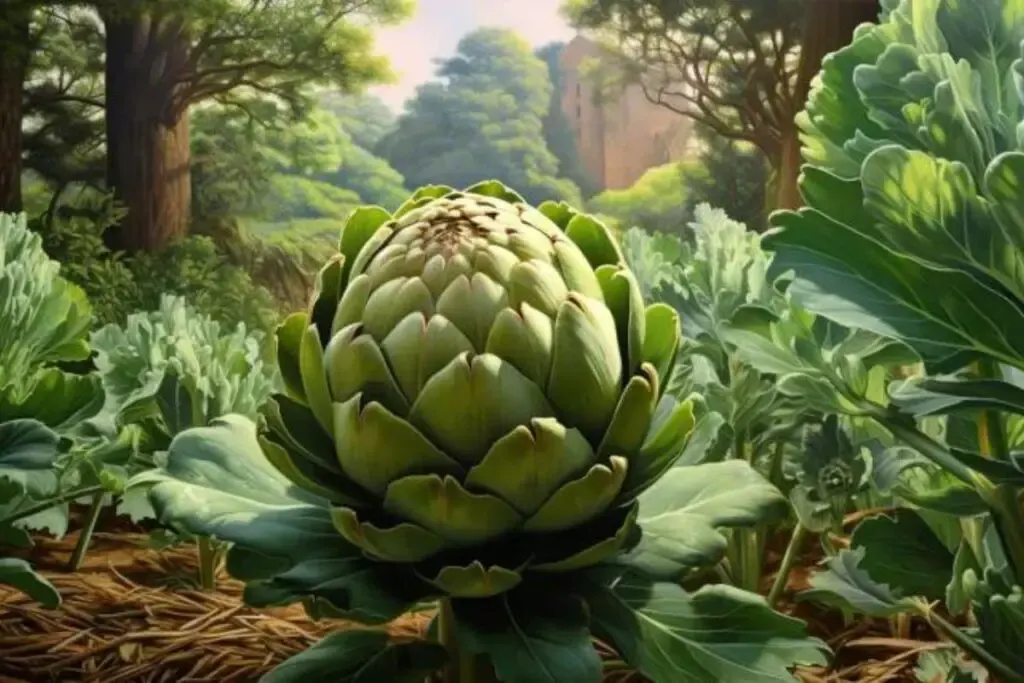
For those who want to start from seed, the Imperial Star is an excellent choice. It’s a fast-growing variety that produces artichokes in the first year from seeds.
This makes it a top pick for those eager to enjoy their homegrown artichokes sooner.
Artichoke Care
Caring for artichokes is a rewarding endeavor that can yield delicious results. These remarkable plants require specific attention to detail to thrive and produce bountiful harvests.
In this section, we’ll delve into the essential aspects of artichoke care.
Planting
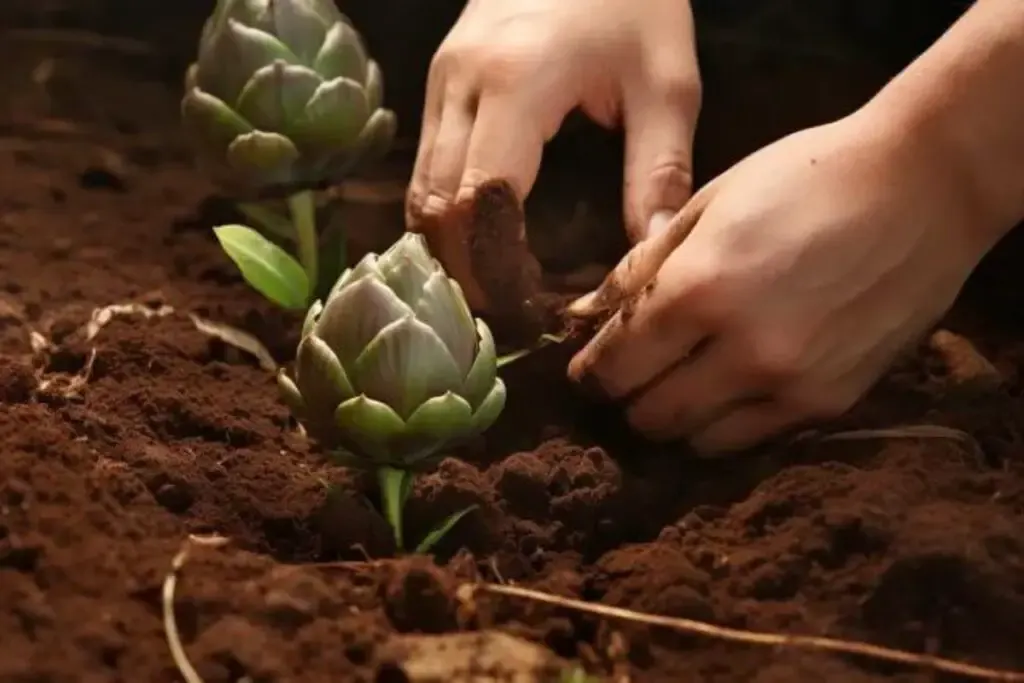
Artichoke planting is a critical step in ensuring healthy growth and a successful harvest. Plant artichokes at least 3 feet apart to allow for their large, spreading growth habit. Providing ample space between plants ensures good air circulation and prevents overcrowding.
When planting artichoke crowns or seedlings, bury them with the crown (the base of the plant) just below the soil surface. Avoid planting too deep or too shallow, as this can affect their development.
Consider companion planting with artichokes to maximize garden productivity. They pair well with plants like tomatoes, basil, and marigolds, which can help deter pests and enhance growth.
Light
Artichokes are sun-loving plants and require plenty of sunlight to thrive. Artichokes thrive in full sun, which means they need at least 6-8 hours of direct sunlight daily.
Ensure they receive adequate sunlight to encourage healthy growth and robust flowering.
Soil
Choosing the right soil and maintaining its quality is crucial for artichoke success. Artichokes prefer well-draining soil to prevent waterlogged roots, which can lead to disease and poor growth.
Amending the soil with compost can improve its drainage and fertility. Aim for a slightly acidic to neutral pH level in the soil, ideally around 6.0-7.0.
Soil testing kits are available to help you determine and adjust the pH as needed.
Water
Proper watering is essential to keep artichokes thriving. Maintain consistent soil moisture, especially during the growing season.
Use a soaker hose or drip irrigation to water deeply and evenly, keeping the soil consistently moist but not waterlogged. Water at the base of the plant to prevent wetting the foliage. Wet leaves can promote fungal diseases, so it’s essential to keep them dry.
Temperature and Humidity
Artichokes are best suited for regions with mild winters and cool, foggy summers. They are sensitive to extreme temperatures and humidity levels. Ensure they are in a climate that matches their preferred conditions.
Fertilizer
Feeding your artichoke plants with the right nutrients is essential for healthy growth and productive harvests.
Apply a balanced, all-purpose fertilizer with equal or near-equal amounts of nitrogen, phosphorus, and potassium. Follow the manufacturer’s instructions for proper dosage and timing.
Regularly incorporate organic matter like compost into the soil to enrich it with nutrients naturally.
Harvesting Artichokes
Harvesting artichokes is a satisfying moment for any gardener, as it marks the culmination of your hard work and patience. Artichokes are ready to be harvested when their buds are plump and tightly closed.
The ideal time is before the bracts (the leaves surrounding the bud) begin to open or loosen. To harvest artichokes, use sharp shears or a knife to cut the stem just below the bud. Be sure to leave some stems attached to the artichoke.
This helps maintain freshness and extends the shelf life. Don’t wait too long between harvests. Regularly pick artichokes as they mature to encourage continuous production throughout the growing season.
Pruning
Pruning artichokes is a key part of their care and can help maintain plant health and encourage productive growth. As artichoke plants grow, their lower leaves may become damaged or die off.
Prune these dead or yellowing leaves at the base to keep the plant looking tidy and allow sunlight to reach the center of the plant.
To encourage larger main bud development, it’s advisable to remove any smaller secondary buds that form on the sides of the plant. This directs the plant’s energy toward producing one robust and flavorful artichoke.
In colder regions, artichoke plants may experience frost damage. In late fall or early winter, prune the entire plant back to a few inches above the ground. Apply a layer of mulch to protect the crown during the winter months.
Propagating
Artichokes can be propagated from established plants by division or from seeds. Divide mature artichoke plants in the spring by carefully digging up the root system and separating the crowns.
Replant the divisions in prepared soil. To grow artichokes from seeds, start them indoors 8-10 weeks before the last frost date. Transplant seedlings into the garden once they are well-established and the risk of frost has passed.
How to Grow Artichokes From Seed
Growing artichokes from seeds can be a rewarding experience. Begin by sowing artichoke seeds indoors in small pots or seed trays.
Plant seeds 1/4 inch deep in a well-draining seed starting mix Keep the pots in a warm location or use a seed heating mat to maintain soil temperatures around 70°F (21°C) for germination.
Once the seedlings have grown two sets of true leaves, transplant them into larger pots or directly into the garden, ensuring they have enough space to grow.
Before planting seedlings outdoors, gradually expose them to outdoor conditions over several days to acclimate them to the outdoor environment. Select a sunny spot with well-draining soil for planting your artichoke seedlings. Space them appropriately, usually 3 feet apart.
Growing Artichokes in Pots
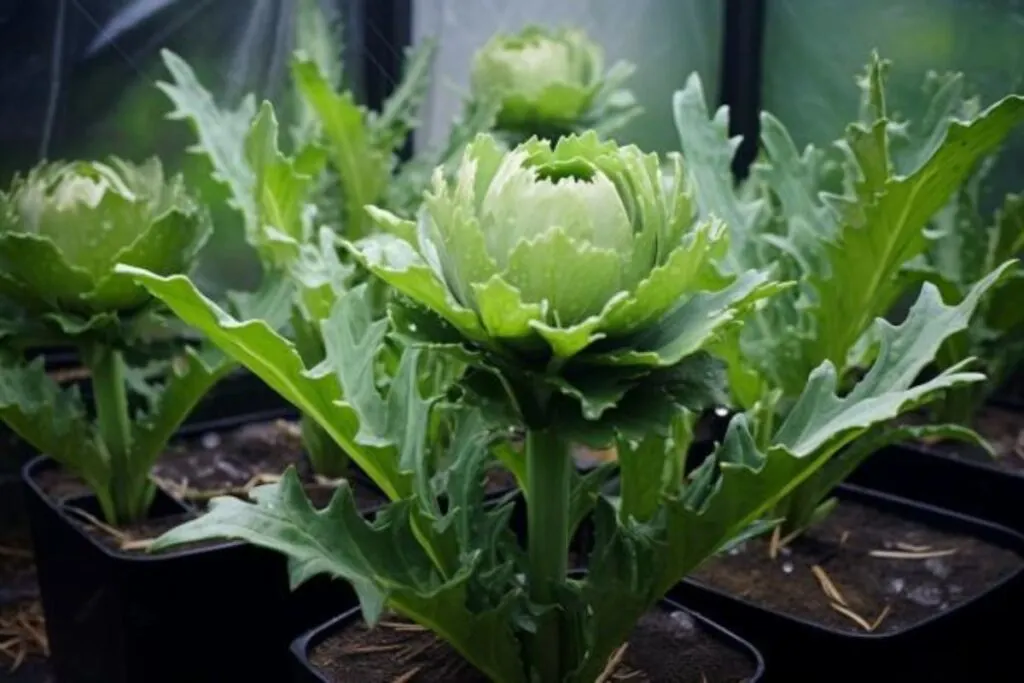
If you have limited garden space or want to grow artichokes on a patio or balcony, they can thrive in pots. Choose large containers with a minimum diameter of 18 inches to accommodate the deep roots of artichoke plants.
Use a high-quality potting mix that provides good drainage. Add organic matter to enhance soil fertility.Place the pots in a sunny location where they receive at least 6-8 hours of direct sunlight daily.
Container-grown artichokes may require more frequent watering. Keep the soil consistently moist but not waterlogged.
Overwintering
Overwintering artichokes is essential in regions with colder winters, as it helps protect these perennial plants from frost and ensures their survival.
- Mulch: Apply a thick layer of mulch around the base of the artichoke plants in late fall. This mulch acts as insulation, protecting the roots from freezing temperatures.
- Cut Back: In colder regions, consider cutting back the foliage to a few inches above the ground after the first frost. This helps prevent frost damage and prepares the plant for winter dormancy.
- Protection: In extremely cold climates, you can provide additional protection by wrapping the artichoke plant with burlap or covering it with a frost cloth. This shields the plant from harsh winter winds and cold temperatures.
Transplanting
Transplanting artichokes may be necessary for various reasons, such as changing garden layouts or improving growing conditions. Here’s how to transplant artichokes successfully:
- Choose the Right Time: The best time to transplant artichokes is in the early spring or late fall when the weather is mild. This minimizes stress on the plants.
- Prepare the New Location: Ensure the new planting site has well-draining soil, receives adequate sunlight, and has sufficient space for the artichoke plants.
- Dig Carefully: Dig up the artichoke plant, including as much of the root system as possible. Be gentle to avoid damaging the roots.
- Replant Quickly: Immediately transplant the artichoke to its new location, placing it at the same depth it was previously growing. Water thoroughly to help the plant settle into its new home.
- Mulch and Water: Apply a layer of mulch around the transplanted artichoke to retain moisture and regulate soil temperature. Keep the soil consistently moist during the establishment phase.
Common Pests & Diseases
While artichokes are generally hardy, they can still face a few common pests and diseases. Being vigilant and taking preventive measures can help keep your artichoke plants healthy:
- Aphids: These tiny, sap-sucking insects can cluster on artichoke leaves. Use a strong spray of water to dislodge them or apply insecticidal soap as needed.
- Slugs and Snails: These mollusks can damage artichoke foliage. Use organic slug and snail baits or traps to control them.
- Gray Mold (Botrytis): Gray mold can affect artichoke buds and leaves. Ensure good air circulation, avoid overhead watering, and remove affected plant parts promptly.
By following these tips for overwintering, transplanting, and managing common pests and diseases, you can enjoy a thriving artichoke garden. With proper care, you’ll be rewarded with delectable artichokes year after year.
Happy gardening!

